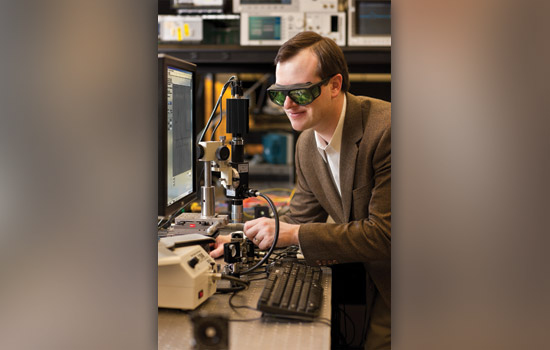Preble Wins Prestigious Defense University Research Program Award
Grant will support next-generation nanophotonics equipment
Provided by Research at RIT
Stefan Preble, assistant professor of microsystems engineering in RIT’s Kate Gleason College of Engineering, is developing silicon nanophotonic devices that use light to control information.
Stefan Preble, a researcher at Rochester Institute of Technology, has been selected as one of the winners of the Defense University Research Instrumentation Program competition for 2011. His project, “The study of dynamically-tuned silicon resonators for Terabit-per-second photonics processors,” will enable ultrafast processing of information in future computers and communications systems.
Preble, assistant professor of microsystems engineering in RIT’s Kate Gleason College of Engineering, is developing silicon nanophotonic devices that use light to control information. His work would enable the processing of terabits, or trillions of bits of information, on a low cost chip.
“This Defense University Research Instrumentation Program award will provide state-of-the-art equipment for fabricating our nanophotonic chips,” says Preble, who is also leader of the RIT Nanophotonics Group. “It not only will enable high performance nanophotonic devices, but will be invaluable to the training of the next-generation of researchers and students. We are delighted that the Air Force Office of Scientific Research has recognized the need for this critically needed equipment.”
Preble’s award was part of a merit competition for funding conducted by the Army Research Office, Office of Naval Research and Air Force Office of Scientific Research. Each organization requested proposals from university investigators conducting science and engineering research of importance to the Department of Defense, especially in the area of chemistry and physics, computing and networks, electronics and electro-optics, neuroscience, fluid dynamics and propulsion, robotics and autonomous systems, and ocean, environmental and biological science and engineering. More than 800 proposals from colleges and universities in the U.S. were received.
NOTE: Preble and his team of researchers in the RIT Nanophotonics Laboratory were profiled in the spring issue of Research at RIT, the university’s magazine about faculty and staff research initiatives.
Rochester Institute of Technology is internationally recognized for academic leadership in computing, engineering, imaging technology, sustainability, and fine and applied arts, in addition to unparalleled support services for deaf and hard-of-hearing students. RIT enrolls 17,000 full- and part-time students in more than 200 career-oriented and professional programs, and its cooperative education program is one of the oldest and largest in the nation.
For two decades, U.S. News & World Report has ranked RIT among the nation’s leading comprehensive universities. RIT is featured in The Princeton Review’s 2011 edition of The Best 373 Colleges as well as its Guide to 286 Green Colleges. The Fiske Guide to Colleges 2011 includes RIT among more than 300 of the country’s most interesting colleges and universities.















